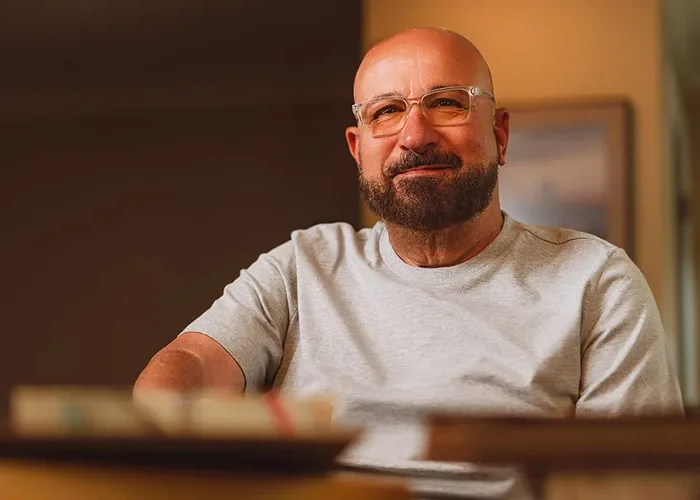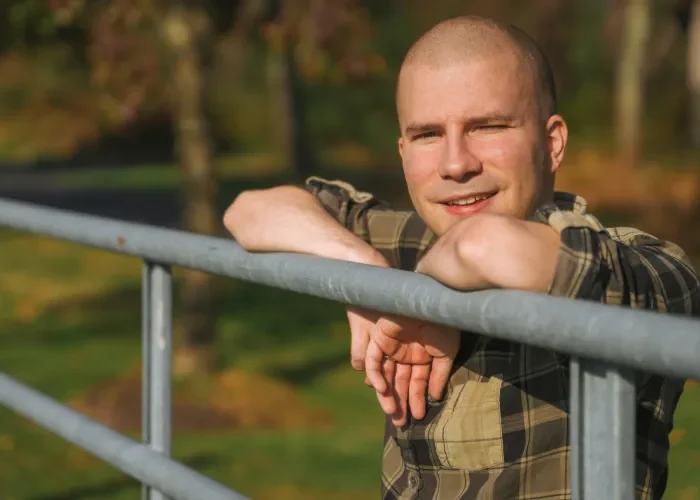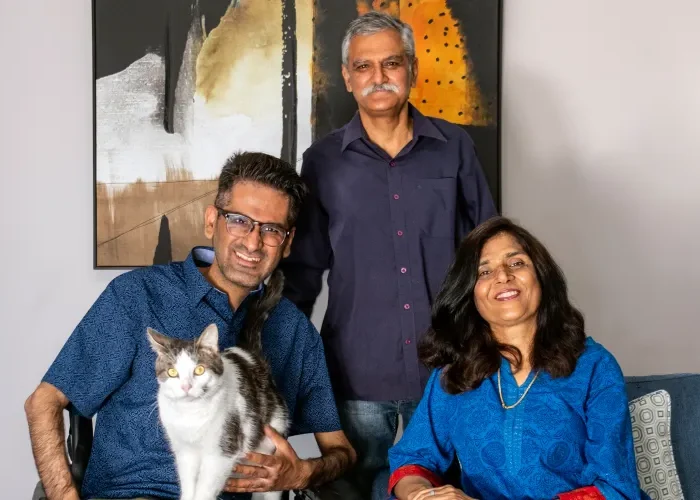When Betty arrives, Mike is in bed. She flips the lights on, as she enters his bedroom and Mike perks up, greeting her with his infectious smile. “Good morning!” he calls out in his energetic New York accent, “Good morning, Mike,” she responds.
For the longer version of this video, click here.
He and his nurse, Betty, have built a special bond over the last several months, since she took over his care, coming to his house six days a week to assist Mike with some of his daily needs. In this time the two have become the truest of friends. “She’s been fabulous with me,” says Mike. “We have a strong bond. We chat about our families, our similarities and differences.”
“I’m definitely a people-person—I love having people around. I love going places. I love life, honestly. I love my home so much.”
For Mike, this has strengthened his resolve as he manages the progressive effects of Becker muscular dystrophy (BMD)—the most significant of these, being that for several months he has relied on wheelchairs to get around.
Betty begins by helping Mike start his day: showering, getting dressed, having breakfast, and doing physical therapy. Mike wheels himself up to his stander and Betty ties a cloth stabilizing belt around his waist. He inches his wheelchair closer and reaches up, grabbing hold of the stander’s arms. Mike rises up, slowly and surely, from his chair to a full standing position.
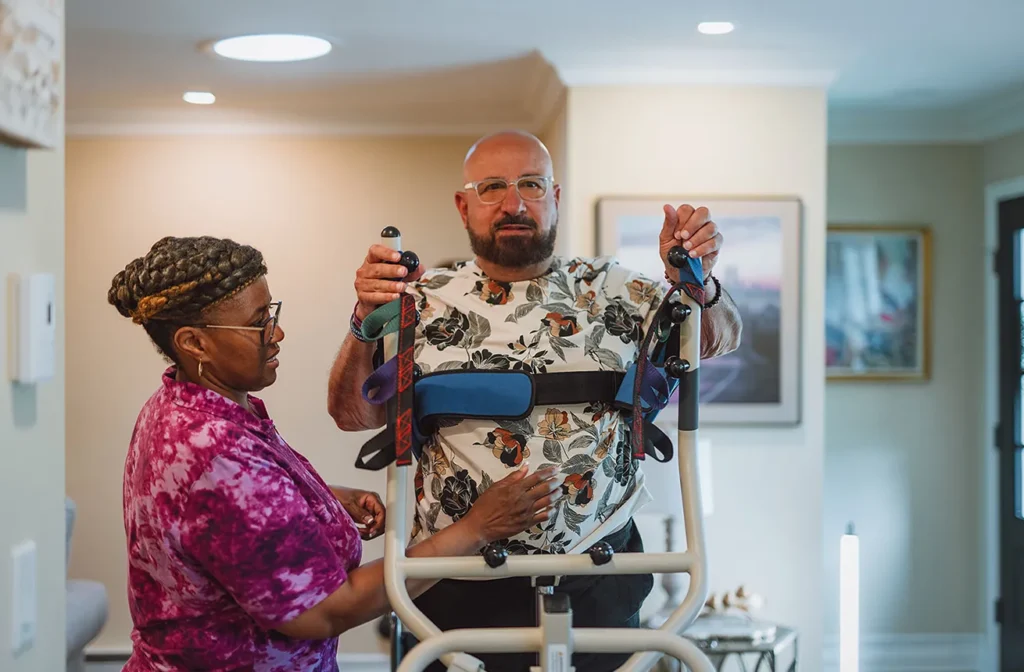
“It feels good on my legs, my calves,” he reports. Mike sets a timer for 15 minutes, half of the length of time he tries to stand each day. With a strap to keep him stable, he shifts his weight from foot to foot, working on balance and stability, in support of his goal of being able to walk again. Also, stretching his legs feels really good and standing helps Mike keep his core muscles in his abdomen developed.
Becker muscular dystrophy is a genetic disease that slowly and progressively weakens Mike’s muscles, starting in his legs and eventually affecting other major muscle groups. However, he will be the first to tell you that he’s lived a full, rich life and maintains a very positive attitude despite recent setbacks. “Even though I’ve slowed down a bit, my life is just great,” he attests.
For the first 64 years of his life, Mike was able to walk independently, albeit with a gait. However, this all changed last summer, when Mike lost balance and fell in his bathroom, banging his knee into the floor and fracturing his tibia and fibula. He couldn’t get up, but was able to call for paramedics using his smart home device. Recovery has been slow.
“I thought I would be back to it quicker,” he admits. “It’s still very much my goal and I am doing everything I can to walk again. I don’t feel cheated. I just feel disappointed.” Every day, Mike’s commitment to his own cause drives him forward. Realistically he knows that taking extended walks around his community in New Jersey probably isn’t in the cards, but rather being able to walk short distances and transfer from his wheelchair with more dexterity are what he’s after. In particular, he is now able to transfer from his wheelchair to his car. “I want to remain independent,” says Mike. “As independent as I can be.”
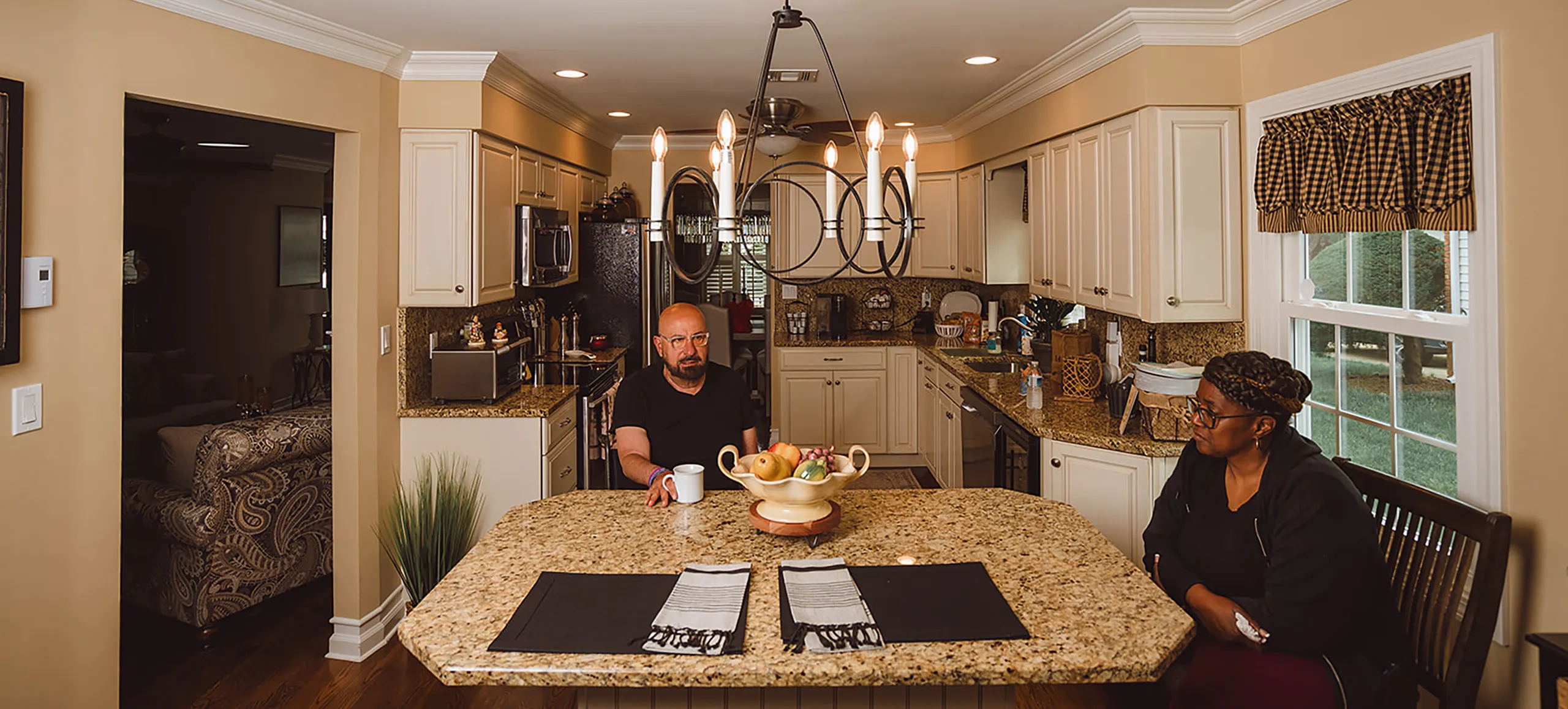
The transition from walking to using a wheelchair has been difficult for Mike, but he’ll also admit that there have been several advantages. “People used to say to me, ‘You could use a power chair Mike,’ but I wasn’t ready yet,” he recalls. “Then, I finally bit the bullet. I had no choice, but boy, has it made my life easier.” With a power wheelchair Mike doesn’t have to stress anymore about getting around his house, or his neighborhood, and importantly, it has assuaged him of the constant fear of falling. “There are advantages to the power chair. It’s brought me so much independence. I never thought a power chair would mean that much.”
After making sure that Mike is all set, Betty heads out for the day. With the sun out and the birds chirping, he takes to the streets around the 55-and-over community where he has retired near the Jersey Shore. Navigating the streets and sidewalks still has its nuances: being aware of tree roots, for example, is important knowledge.

Mike rolls up to the community clubhouse—a large building surrounded by recreation areas. He proceeds over to the construction site where a new pool is being built and looks on with pride. “It’s going to be a zero-entry pool,” he explains, excited. The accessible design feature will allow Mike to roll himself into the water unencumbered by steps, steep drops, or barriers. Furthermore, he negotiated himself a water-wheelchair that he can keep chained up right nearby, giving him easy access to the pool whenever he wants.
Inside the clubhouse, Mike’s passions and community mindset come into focus. As a chairperson and committee member, he is responsible for upkeep of the building and helps organize events for the community, including a Men’s Group that he chairs. Parties, dances, and cultural events all take place here. Mike pulls the blackout curtains closed in the theater and the party lights come on. A disco ball spins and sends different rays of color bouncing off the walls, reflecting off his eyeglasses. Mike’s smile lights up and he is transported from the humdrum of everyday life back to the nightclubs of his youth.
“I really came out of my shell at the nightclubs of Manhattan,” he says. “Studio 54, New York, New York… I went to all the clubs back then.” The native New Yorker, born on Staten Island, found his groove during the rise of disco and the burgeoning nightclub scene in Manhattan. “I loved to be on the dance floor,” he recalls. “However, sometimes, I ended up on the floor.”
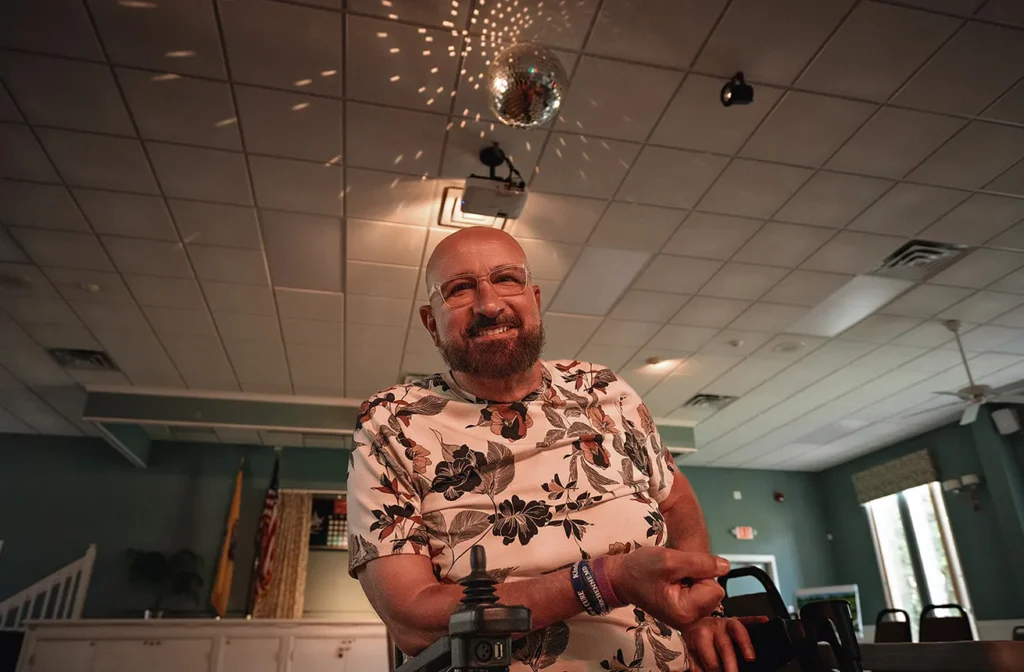
These falls were not due to drunkenness. Despite his best efforts, he often fell over, his legs suddenly becoming unsteady and his footing lost. His friends would simply pick him back up and he’d go back to dancing, but an explanation eluded him. He had been falling for most of his life, and didn’t know why.
“I never was a fan of gym class,” Mike remembers. Growing up on Staten Island he had played in the streets with his brother and other kids, and for the most part, could manage. However, a kindergarten teacher had brought up his issues to his mother, who took him to see a neurologist. Mike doesn’t remember the visit well, but the doctor was quick to diagnose him. “The doctor diagnosed me with Duchenne muscular dystrophy and told my mother to take me home and love me because I’d be dead by 12.”
Faced with startling news, Mike’s parents sought a second opinion. In the meantime, they took Mike on trips and showed him the world, not knowing how long he would have to see it. However, as Mike grew, it became clear to doctors that he did not have Duchenne, and they reversed the diagnosis.
And so, Mike grew into adolescence and adulthood with the assumption that he didn’t have muscular dystrophy. He graduated from DeVry Technical institute and began working various jobs as a repairman around the metro NYC area, fixing copiers, printers, and fax machines in offices. Walking for hours around Manhattan and climbing stairs was tiring and difficult for Mike. “Sometimes my knee would just give out,” he recalls.
“I never wanted to accept the fact that I was handicapped,” says Mike. “I wanted to look and walk normal.” However, in his 30s, Mike finally visited an orthopedist, who recommended he see a neurologist. The neurologist suspected that Mike had Becker muscular dystrophy, not Duchenne, and gave him a long list of prescriptions. Mike wasn’t ready for all the information. On his way out the door, overwhelmed and confused, he tossed the prescriptions into the wastebasket and went back to living his life.
He continued to live at home in Staten Island, taking care of his parents until their health began to decline. In 2000, both his mother and his father passed away and suddenly, Mike found himself living alone in his two-story, childhood home.

It was then that he finally began to accept that he likely did have Becker, and began taking steps to get an accurate diagnosis. After visiting a few neurologists, finding an expert at Cornell, he was advised to take a genetic test. At 43 years old, in 2003, Mike finally learned what had been going on with his body since he was a boy.
Ultimately, getting diagnosed with Becker was helpful for Mike, although he remains grateful that it was not prevalent in his earlier life. “I had a whole life before I started slowly declining,” Mike reflects. “I’m so glad I didn’t know I had the disability until I was an adult. I was grateful for my misdiagnosis because it gave me a full life. Not knowing I had this disease was the best thing that could’ve ever happened to me.”
In the last twenty-odd years, Mike’s views on living with Becker have changed dramatically as a level of acceptance has coupled with his natural graciousness to create a rare disease advocate. “I’m so committed to the community of people living with muscular dystrophy,” he states. Finally meeting others with Becker and Duchenne forever changed Mike’s life and transformed his consciousness around his health, disability, accessibility, and emerging technologies aimed at treating the disease.
“I’ve been part of the Adult Advisory Committee at Parent Project Muscular Dystrophy [PPMD] for years now,” says Mike. “I’m the grandpa of the group. We make jokes about that. Being this old and relating to young men with this disease is so cool.” Mike has worked with the MDA, PPMD, and other, smaller advocacy organizations, helping to raise awareness for research. “I see myself continuing to get more and more involved,” he says. He is planning on attending numerous conferences and completing an imaging study this year, traveling great distances, often with Betty at his side.
“I’m definitely a people-person–I love having people around. I love going places. I love life, honestly. I love my home so much.” On his way home from the clubhouse, Mike stops frequently to chat with neighbors. He is planning to host dinner for a few of them tonight.
Mike’s house is covered in memorabilia from his life, pictures and artifacts from the myriad of experiences and other people that are important to him. From the pictures of his grandparents—immigrants from Italy—to new photos of his nieces and nephews, Mike has filled his home with the presence of those he holds dear. His gregarious nature comes out as he tells stories of each family member and how important they are.
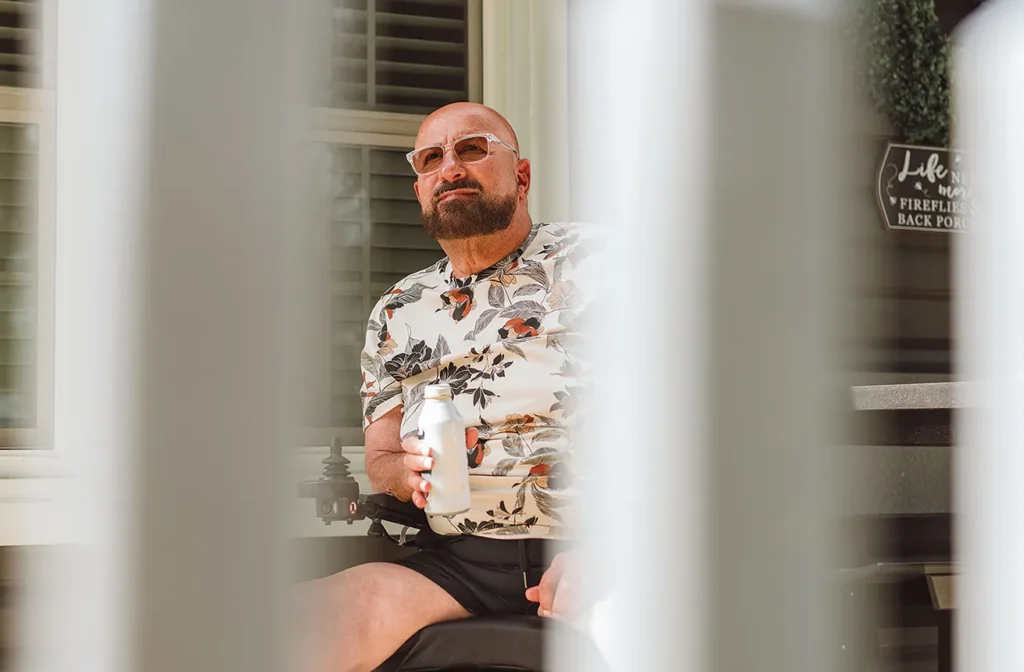
“I was able to host Easter dinner this year,” he remarks. Mike loves to welcome his family, many of whom live in Jersey or New York City, who make the trip to visit him frequently, especially for holidays. “One limitation I have is that it’s difficult to go to my family members’ houses with my wheelchair,” he explains. “That is one drawback of Becker.”
Ultimately, Mike has accepted some of these hard truths, while reveling in the time he does get to spend with loved ones in his home or in his community. While he understands certain parts of the world will continue to be difficult for him, he learns to work with what he has to fill his life with the things that bring him joy.
In his backyard, Mike waters some of his plants. Gardening is something that he missed for years as he struggled to bend over. However, now in the power wheelchair he can douse the plants with water with relative ease. “I can do just about anything myself now,” he gloats. “It makes me feel like a whole person again.” Learning to adjust to life with Becker has taught Mike many lessons, and ultimately, has provided a path forward. He cracks open a beer and enjoys the waning sun from his back deck, comfortable, secure, and in it for the long haul.
